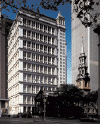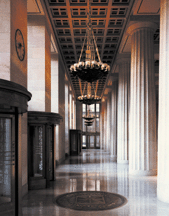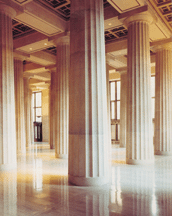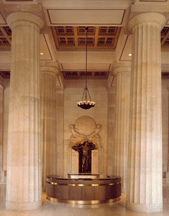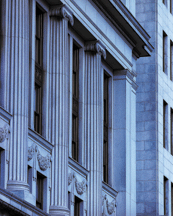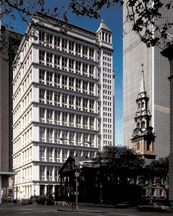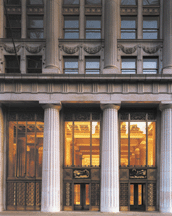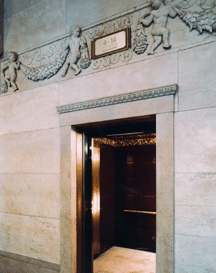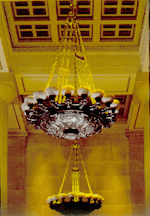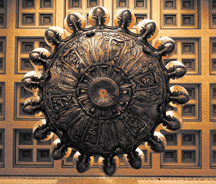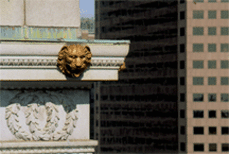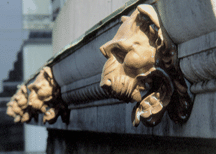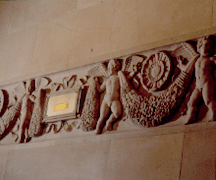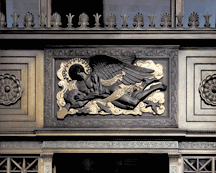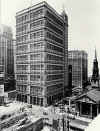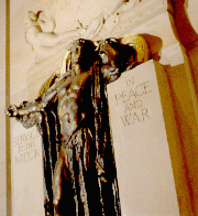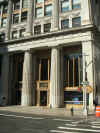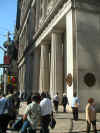|
notes
|
Originally American Telephone & Telegraph Company Building (offices)/now 195
Broadway Building.
"The square-topped layer cake of New York:
a deep-set façade of 8 lonic colonnades (embracing 3 stories within each
set) is stacked on a Doric order."
This building has the distinguish honor of
having "more Classical columns than any façade in the world."
|
Visit 195
Broadway and you'll be reminded of Greece and Rome's great
civic monuments. Soaring Doric columns, decorative bronze
ornamentation and shimmering marble walls grace the lobby. The
exterior is styled directly on the Septigorim in Rome, and features
dozens of massive, granite columns. This property truly makes a
statement of corporate success to existing and potential tenants and
visitors alike.
AT&T commissioned famed architect William Welles Bosworth to design
195 Broadway as its corporate headquarters in 1913. AT&T asked that
the building impart a sense of solidity, permanence and enduring
quality. Obviously Bosworth met that challenge - AT&T stayed over 70
years.
|
|
HISTORY |
Architect
William Wells Bosworth, one of the most well-respected
architects of his day, designed 195 Broadway as AT&T's
corporate headquarters in 1913. This architect's use of
classic design elements and meticulous attention to detail
resulted in one of the most beautiful buildings ever to
grace Manhattan's streets. Bosworth considered 195 Broadway
one of his greatest accomplishments, referring to it as his
"temple on Broadway."
| Other
Bosworth architecture includes: |
|
• |
Massachusetts Institute of Technology. |
|
• |
The
Rockefeller home and gardens in Pocantico Hills. |
|
• |
The
Theodore Vail House in Morristown, New Jersey. |
|
• |
Restoration of
Versailles, Fontainebleau and Rheims Cathedral in
France.
|
|
Little Known Facts |
|
• |
The
interior of 195 Broadway is reputed to contain more
marble, in cubic feet and weight, than any other
building in New York. |
|
• |
All the
marble was cut and polished in New Jersey, then
floated by barge to Manhattan. Eight-horse teams
hauled it to the site. |
|
• |
The
original 26th floor roof sported handball and squash
courts surrounded by plush deck chairs. |
|
• |
Bosworth
was so finicky about matching the marble, a special
representative was sent to the quarries and tons of
marble were rejected. |
|
• |
The building was
initially steam-heated and powered by coal, which
was delivered to the basement by sidewalk lifts.
|
|
 |
|
|
EXTERIOR |

|
Bosworth's inspiration for
195 Broadway's exterior was a Roman structure erected by
Septimius Severus which contained seven stories of columns.
Note, however, that his design of 195 Broadway aligned the
columns horizontally, as opposed to the vertical layout more
common in buildings of this type.
All 198 exterior columns and the exterior walls are
constructed entirely of Vermont granite. The extraordinary
use of decorative bronze on the windows, spandrels and a
multitude of details help create the lasting impression of
this masterpiece.
|
|
|
LOBBY |
|
The lobby of 195 Broadway is
New York's link with Periclean Athens. Soaring marble
columns, graceful proportions, alabaster chandeliers and
polished bronze unite to create a breathtakingly
beautiful setting reminiscent of the Greek Parthenon.
|
Contributing to the magnificence of the space are: |
| • |
More
than 50 Doric columns crafted of rare marble -
Napoleon Gray, Botticino and Istria - rising to a
height of almost 40 feet. |
| • |
Elegant
chandeliers crafted of bronze, German silver and
fine alabaster. |
| • |
An
intricate gilded vaulted ceiling with starburst
motifs. |
| • |
Cast
bronze ornamental grills adorning the entryways and
balcony. |
|
• |
An ionic-style
bronze and marble directory and carved marble
letterbox.
|
|
 |
|
|
ORNAMENTATION |

|
The exquisite ornamentation of
195 Broadway draws on classic themes and shapes. Leading
sculptors collaborated with Bosworth to craft unique
artwork, employing such luxurious materials as stained
glass, bronze and marble.
|
Paul Manship created many distinctive bronze
sculptures: |
| • |
The
turbaned Oriental maidens supporting the drinking
fountain spouts. |
| • |
The
handcarved cupids above the elevators with
assistance from Gaston Lachaise, another prominent
sculptor. |
| • |
The plaque
of Alexander Graham Bell. |
Chester Beach sculpted the "Service to the Nation in Peace
and War" marble and bronze piece for the lobby in 1928. |
|
|
